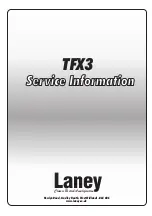
19
10.3
USING YOUR DX-3
While tuning and adjusting the amplifier, a CW mode is normally used. When these operations are finished, you
can change to the operating mode you wish to use and start operating.
10.3.1
CW / RTTY and all digital modes
In CW, the setting up of the amplifier is similar to that of the tuning mode. After adjusting the input power level
to the amplifier, according to the desired output level, and tuning the plate and load capacitors, you can simply
start operating by applying the same carrier level as during tuning. If the amplifier is set to deliver full output
power, or close to, then screen current will be present. As in the case of tuning, the best operation is achieved
when there is a certain amount of screen current flowing, corresponding to two or three red LED's turning on in
the Ig2 display.
10.3.2
Voice modes (SSB)
When a voice modulation is applied to the amplifier, the drive level is not precisely defined, as in the case of
tuning with continuous carrier. If there is screen current flowing, or an input overdrive, they will be indicated
only at peak of modulation, by the respective indicators flashing. You will have to adjust the microphone gain,
or the RF drive, or both, in an attempt to achieve input driving conditions similar to those you have used while
tuning. Occasional flashing of the overdrive indicator is acceptable. If the over-driving is severe, a momentary
cut-off will occur.
10.3.3
Hints on good linearity and efficiency
Operating with good efficiency
:
If you are watching the plate current indicator, you must be aware that the total power the amplifier is drawing
from the mains is proportional to the plate current. Power that is not sent to antenna, is dissipated by the tube.
As explained in the Tuning section, the best tuning achieves a maximum power output at the same time with a
minimum plate current, drastically minimising the tube dissipation. Be aware that at a low power level, slightly
different tuning is required than is for full power.
Achieving the best linearity:
The amplifier must be tuned and operated all the time in the linear mode. This is important because a non-linear
operation will generate harmonics which will disturb RF communications in other bands and frequencies.
We must distinguish two situations:
Less than full power.
With less then full power (say 2000W or less), correct tuning, no screen current and no input overdrive
indication, you will
always have your DX-3 operating with a good linearity and clean signal.
Full power operation.
At full power, there are two things that must be watched to see when you reach the limit of linear operation: the
screen current, Ig2, and the grid current, indicated by the "Over-drive" LED.
In this case a good linearity is maintained up to the moment when the screen current is approaching the full
scale value of the Ig2 indicator and it starts flashing, or when the overdrive indicator fully turns on.
A high screen current, indicated by 4 LED's on in the Ig2 display, will create a moderate level of distortion.
Even a small amount of grid current will cause severe distortion. When the "Over-drive" indicator just begins to
turn on, there is a very small amount of distortion, created by a grid current of about 100 microamperes.
With this indicator flashing, you are at the limit of the RF carrier clipping. This is probably more acceptable in a
voice mode of operation. In CW or digital modes, the best is to slightly reduce the drive, just below this level. A
severe level of over-driving is not possible anyway, due to the cut-off protection. The cut-off will happen at
about 400 microamperes of grid current.
See the Appendix 2 and the Troubleshooting section for oscilloscope
displays showing examples of a two tone generator driving the DX-3 in linear mode, and an overdrive situation,
when a DX-3 with the overdrive protection disabled is being overdriven by the two-tone generator.















































